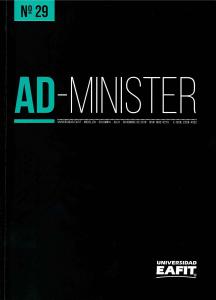Analysis of service management structures in companies from the service sector
Main Article Content
Keywords
Organizational structure, Service management, Competitive strategy, Services marketing
Abstract
The study that guided this article was done with the purpose of evaluating different service approaches that are articulated as part of the strategies that guide the philosophy of eight organizations. To achieve this, different theoretical perspectives about the service are used, and with the method of case study eight successful companies from Antioquia that developed their organizational structures for service management are studied. The review using models obtained by the literature and the comparison of each case study approaches, allowed to find similarities that can set some guidelines to follow in formulating a service structure, considered as a strategy of differentiation and success factor. The study gives an idea of how to implement models to analyse and evaluate the performance of service, which in future can also be studied from clients / customers. The limitations are related to the recent use of the concept of “servitization” practices which are still subject of discussion.
Downloads
References
Bozkurt, O., & Kemer, B. (2014). The impact of Service Differentiation, Informational capacities and commitment to Exporting on Export Costs and Growth Performance. Economics, Sociology and Policy Journal, 10(1), 53-80.
Csaszar, F. A. (2012). Organizational Structure as a Determinant of Performance: Evidence from mutual funds. Strategic Management Journal, 33(6), 611-632.
Dasgupta, S., & Singh, A. (2005). Manufacturing, Services, Jobless Growth and the Informal Economy: Will Services be the new engine of economic growth in India? Cambridge: Centre for Business Research, University of Cambridge.
Dierickx, I., & Cool, K. (1989). Asset stock accumulation and sustainability of competitive advantage. Management Science, 35(12), 1504-1511.
Euromonitor Internantional. (mayo, 2014). Passport. Recuperado de: https://www.portal.euromonitor.com/portal/default.aspx
Gannon, C., Lynch, P., & Harrington, D. (agosto, 2014). Does sustainable competitive advantage exist? And, if so,
How can it be achieved? Recuperado de: http://repository.wit.ie/1555/
Gebauer, H., & Fleisch, E. (2007). An investigation of the relationship between behavioral processes, motivation, investments in the service business and service revenue. Industrial Marketing Management, 36(3), 337-348.
Gebauer, H., Gustafsson, A., & Witell, L. (2011). Competitive advantage through service differentiation by manufacturing companies. Journal of Business Research, 64(12), 1270-1280.
Gebauer, H., Pütz, F., Fischer, T., & Fleisch, E. (2009). Service Orientation of Organizational Structures. Journal of Relationship Marketing, 8(2), 103-126.
Grönroos, C. (2009). Marketing as promise management: regaining customer management for marketing. Journal of Business & industrial Marketing, 24(5-6), 351-359.
Kindström, D. (2010). Towards a service-based business model - Key aspects for future competitive advantage. European Management Journal, 28(6), 479-490.
Kowalkowski, C. (2011). The service function as a holistic management concept. Journal of Business & Industrial Marketing, 26(7), 484-492.
Miles, R. E., Snow, C. C., Meyer, A. D., & Coleman Jr., H. J. (1978). Organizational Strategy, Structure, and Process. Academy Of Management Review, 3(3), 546-562.
Ministerio de Trabajo de Colombia. (21 de junio, 2014). Población Ocupada por Sexo según Rama de Actividad Económica. Recuperado de: http://www.mintrabajo.gov.co/component/docman/doc_download/307-totalnacionalocupados-por-sexo-segun-rama-de-actividad.html
Oliveira Teixeira, R. D., & Werther Jr., W. B. (2013). Resilience: Continuous Renewal of competitive advantages. Business Horizons, 56(3), 333-342.
Raddats, C., & Burton, J. (2011). Strategy and structure configurations for services within product-centric businesses. Journal of Service Management, 22(4), 522-539.
Romero Amado, J. (2014). El sector servicios en la economía: el significado de los servicios a empresas intensivos en conocimiento. Recuperado de: http://herzog.economia.unam.mx/lecturas/inae3/romeroaj.pdf
Roth, A. V., & Menor, L. J. (2003). Insights into Service Operations Management: A Research Agenda. Production and Operations Management, 12(2), 145-164.
Ruta N. (26 de julio, 2014). Landing: A Program For Foreign It Companies. Recuperado de: http://rutanmedellin.org/index.php/es/component/zoo/item/landing-a-program-for-foreign-it-companies
Srivastava, M., Franklin, A., & Louis, M. (2013). Building a Sustainable Competitive Advantage. Journal of Technology Management & Innovation, 8(2), 47-60.
Vandermerwe, S., & Rada, J. (1988). Servitization of business: adding value by adding services. European Management Journal, 6(4), 314-324.
Vargo, S. L., & Lush R. (2004). Evolving to a New Dominant Logic for Marketing. Journal of Marketing, 68(1),
1-17.
Vargo, S. L., Maglio, P. P., & Akaka, M. (2008). On Value and Value co-creation: A service systems and service logic perspective. European Management Journal, 26(3), 145-152.
Yin, R. K. (1984/2014). Case Study Research: Design and Methods, Applied social research. Methods Series,
Newbury Park CA: Sage.
Zaridis, A. D. (2009). Competitive Advantage and its Sources in an Evolving Market. Computational Methods in Science and Engineering, Advances in Computational Science, 216-220.

